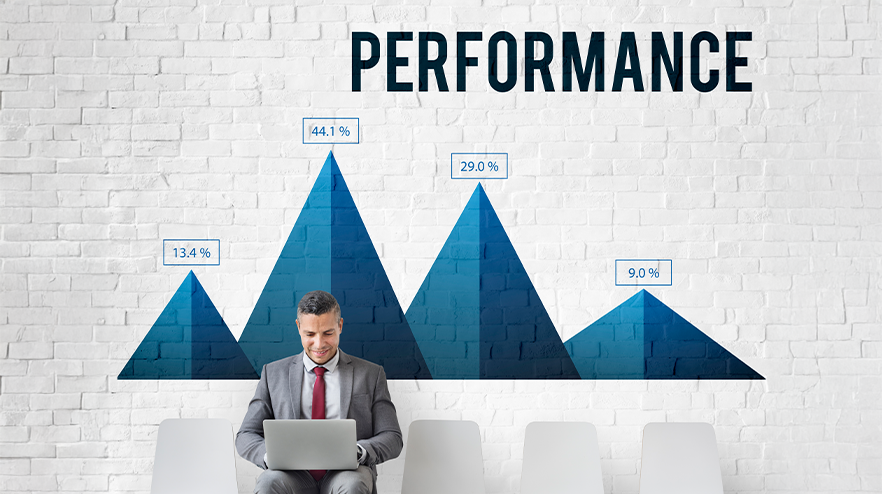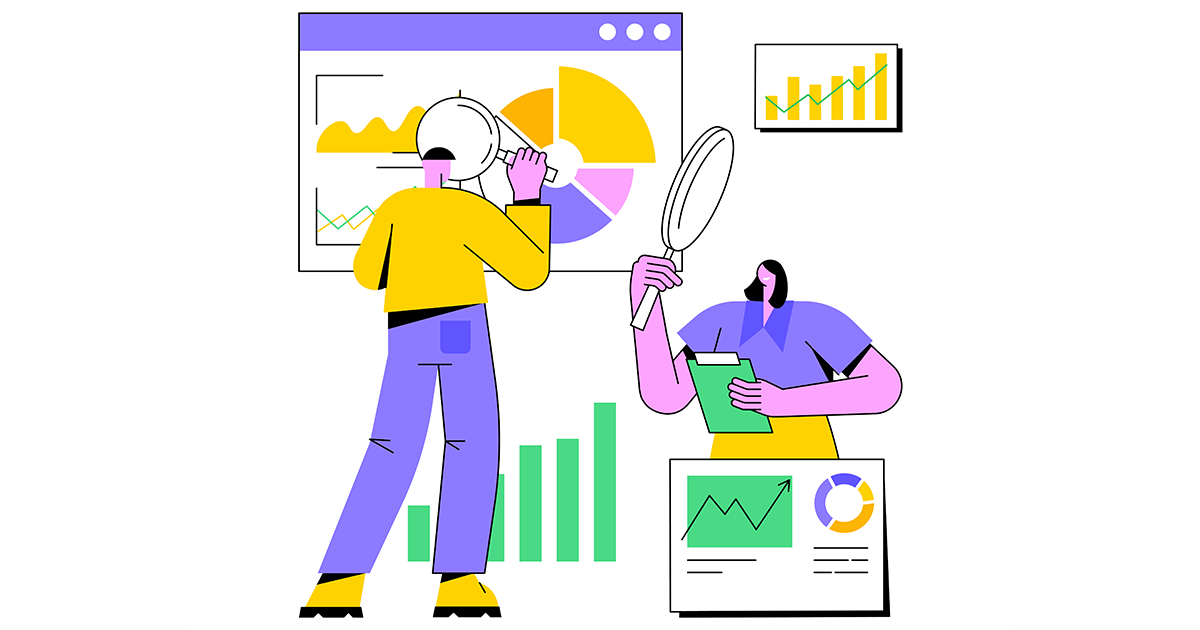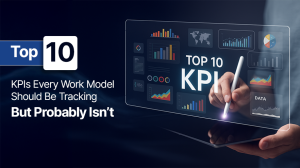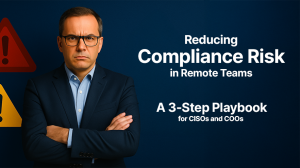Table of Contents
Are you experiencing a delay in business growth? It may be because of your low-performing team. According to a Gallup report, teams with a higher percentage of low-performing or disengaged employees derail productivity by 34%, causing a loss of reputation, performance, and billions of dollars annually.
Even in 2025, most businesses don’t know how to accurately measure employee performance. Without appropriate data, one can easily make the wrong decisions, including rewarding the undeserving, overlooking hidden talent, or letting poor performance slip their dream business.
And many companies still rely on outdated reviews or their gut, which can result in poor productivity, disengaged employees, high turnover, the risks of losing it due to low performance employee is higher particularly with remote and hybrid workforce.
That’s also why it’s essential to have clear performance metrics, which can be reinforced through workforce management. Employee monitoring software allows you to track activities, attendance, time and productivity scores in real-time, so you can take data-driven decisions and boost workforce management.
In this blog, we’ll guide through key metrics and challenges to measure employee performance in an actionable approach.
Why Measuring Employee Performance is Crucial for Businesses
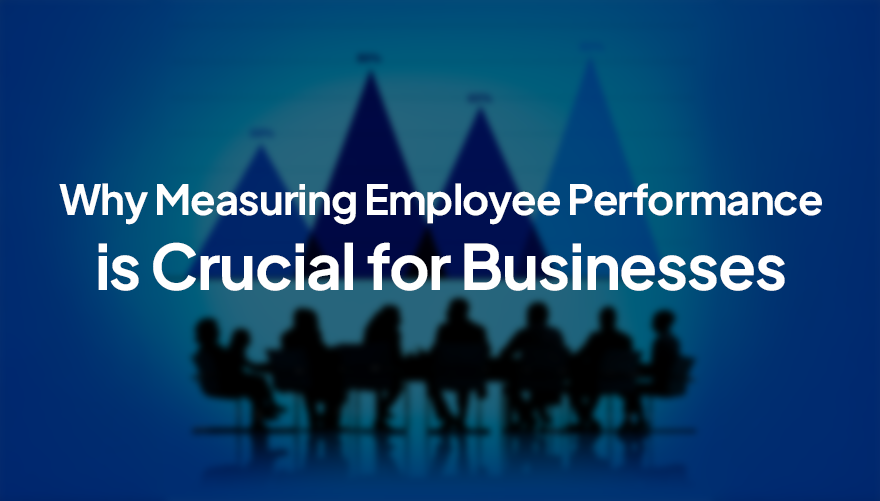
Assessing employee performance is very important for any company. Without clear data to measure, it’s hard to know who is doing well and who may need further assistance. This lack of visibility can make it difficult to make decisions about promotions, raises, or terminations.
In addition, engagement rate of employees has falling from 23% to 21% in 2025, which cost an estimated $438 billion in productivity, according to Gallup. These numbers show the consequences of underperformance and disengaged workforces.
Employing performance tracking software can help business owners to get clear insights on these potentially expensive mistakes. With employee monitoring software, you can measure vital metrics, such as time, work efficiency, and productivity. Additionally, it helps in creating a culture of accountability and is the most effective way to get your team in sync with company objectives, which leads to business growth and overall success.
Read more: 5 Ways To Monitor Employee Performance

Is Your Team Holding Back Business Growth?
Get a detailed productivity report using our employee performance software—no setup or tech skills required.
Challenges Businesses Face While Measuring Employees’ Performance
Evaluating performance metrics is challenging for small business owners, especially with constrained budgets and resources. Many companies continue to depend on antiquated or occasional audit and performance reviews; arbitrary methods provide inaccurate data during evaluation.
Another challenge is remote and hybrid teams, with workers scattered in different locations, it becomes more difficult to monitor productivity and task completion. The inability to have face-to-face interactions leads to transparency, making it hard to evaluate accurate performance. Due to a lack of transparency, employees may feel isolated and unsupported, leading to lower productivity and poor engagement.
A frequent problem is also the absence of an activity monitoring system to measure how engaged workforce is performing. Overlooking key metrics and engagement rates can lead to poor performance, staggering turnover, and low morale among workforces.
Top Key Metric to Measure Employee’s Performance:
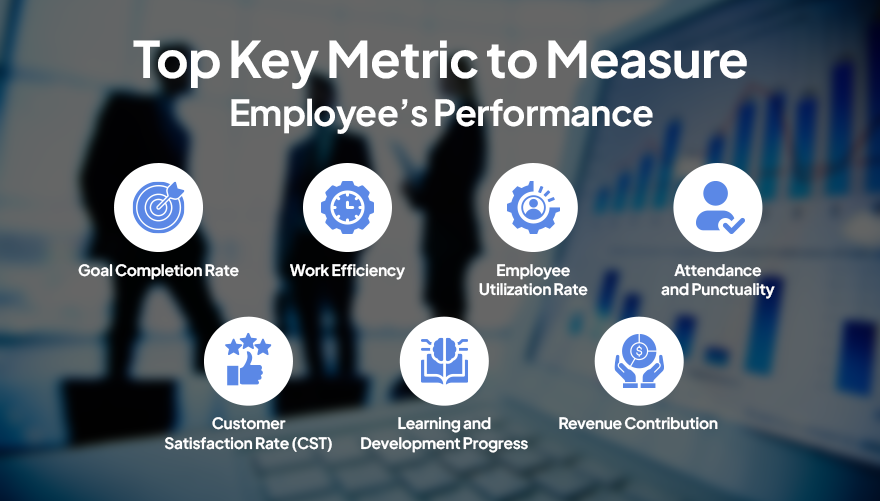
It is important for businesses to understand and evaluate real time insight of these key performance metrics, such as efficiency, productivity, customer satisfaction rate and revenue contribution to ensure sustainable growth.
- Goal Completion Rate
Goal completion rate monitors the degree to which employees achieve defined goals. It focusses on the role of the individual in reaching both short-term and long-term goals. This KPI keeps your staff aligned with your company goals, keeping employees on track and ensuring that they are productive.
- Work Efficiency
Work Efficiency indicates how much longer an employee takes to complete a task than expected. It can also pinpoint bottlenecks that can be improved, so workers are working efficiently. Higher efficiency can help business to grow and can reduce operational costs.
- Employee Utilization Rate
It shows how efficiently staff members are using their time for billable or productive tasks. A high utilization rate suggests that the workforce is used optimally and efficiently with respect to cost.
- Attendance and Punctuality
Attendance and punctuality measure reliability and dedication to the position. No-shows or lack of dedication toward the respective role can affect a team’s productivity and project schedules. Following this strategy helps teams to keep the pace and encourages teams to respect deadlines and office standards.

Get Accurate Workforce Analytics with wAnywhere
- Customer Satisfaction Rate (CST)
The customer satisfaction rate is a measurement of how well the staff serves customers, which affects the company’s reputation. High CST is associated with high quality employee performance, particularly with customer service employees. The metric allows businesses to measure how much responsibility employees are having for their customers’ experiences and loyalty.
- Learning and Development Progress
Learning and development progress measures the development of your employees through training, learning new skills, and receiving certification. This measure shows in growing attribute of employee for improving their skills and knowledge and stay up to date in the trends and technologies, increasing the value to the company and facilitating career growth.
- Revenue Contribution
Revenue contribution indicates how an employee can directly or indirectly influence the company’s revenue. This metric is important for sales teams but actually pertains to all positions in their contribution to growth. For example, a marketing team boost ROI by 2X and contributes around 30% of total revenue, this data of revenue contribution showcases a highly performance team.
An accurate insight on key metrics on how to measure employee performance can assist businesses in data-driven decisions to experience sustainable growth and boost productivity.
How Employee Monitoring Software Helps in Measuring Performance
It is a versatile solution for measuring and enhancing employee productivity. This software, like wAnywhere provide real-time employee monitoring, task tracking, and productivity analytics designed for modern businesses provides real-time information to allow business owners to make data-based decisions strategies to boost productivity and growth.
It automatically tracks key metrics, including clock in and out, productivity reports, attendance tracking, screenshots, and app usage. For example, it helps them to track how much time is being devoted to tasks, what tools are being used and whether deadlines are being met.
It eliminates guesswork by reporting based on real time insights, which helps managers understand who performance and make data-driven strategies. Monitoring software saves managers time by reducing manual efforts to check performance or rely on biased feedback. Accurate insights can be easily derived from reports and dashboards that transparency and accountability.
Employing this software can increase productivity, provide real-time evaluation for better resource planning.
Read more: How To Optimize Employee Performance
Conclusion
Measuring employee performance isn’t just a management responsibility; it’s a business necessity. Poor tracking, lack of transparency, and loss of engagement are some of the major factors that can quietly sap productivity and affect the growth of your workforce. But with the correct approach and tools, you can transform these hurdles into opportunities for growth.
Measuring key metrics, such as employees’ productivity ratios, utilization rate, task completion, activities, and work behavior—businesses can have actionable workforce analytics, from login to logout. With these in-depth reports, managers can optimize workflows, reduce work overload, and make decisions backed by data.
How wAnywhere’s productivity monitoring solution help businesses to measure performance? With our most user-friendly employee monitoring software, business owners can effortlessly track workforce performance in real-time, including crucial productivity parameters like active time, idle time, activities, time spent on tasks, tech usage, attendance and more—all without the need of any micromanagement.
wAnywhere break down complex productivity reports into easy-to-understand visual data, from micro to macro level—helping managers to compare productivity and analyze work patterns with ease. You can download these reports in Excel, CSV, or PDF files for improved data analysis and team collaboration.
Whether you’re building your remote team or scaling your hybrid or in-office teams, wAnywhere lets you make smarter decisions without breaking the bank—all with a 3-minute setup and unlimited integrations for scalability and flexibility.

Is Your Team Holding Back Business Growth?
Get a detailed productivity report using our employee performance software—no setup or tech skills required.

